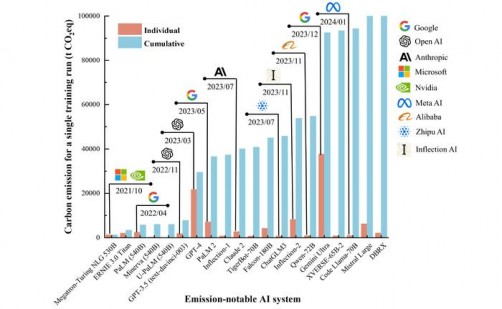Summary: A groundbreaking study has revealed the staggering environmental impact of artificial intelligence systems, with researchers estimating they could emit over 102 million tons of CO₂ annually. The analysis of 79 major AI systems shows that operational demands far exceed training emissions, with some systems like Google’s Gemini Ultra accounting for over a third of emissions among top AI models.
Journal: Frontiers of Environmental Science & Engineering, October 20, 2024, DOI: 10.1007/s11783-024-1918-y
Reading time: 4 minutes
The Growing Environmental Challenge
As artificial intelligence transforms our world, it carries an hidden environmental cost. New research reveals that AI’s carbon footprint has grown so large it rivals the annual emissions of entire countries.
A comprehensive study from Zhejiang University and Nankai University has analyzed the environmental impact of 79 major AI systems developed between 2020 and 2024, revealing alarming trends in energy consumption and carbon emissions.
Unprecedented Scale of Emissions
The findings are striking. Google’s Gemini Ultra model alone accounts for 36.7% of emissions among top AI systems, while GPT-4’s emissions have increased twelvefold compared to its predecessor.
Dr. Meng Zhang, lead researcher from Zhejiang University, notes: “The exponential growth in AI capabilities mirrors a concerning rise in its environmental impact. This study underscores the urgent need for the AI industry to adopt greener practices and sustainable standards. Our goal is to equip policymakers with the data needed to address AI’s carbon footprint through proactive regulations.”
Economic Implications
The environmental impact carries significant economic consequences. With carbon priced at $109 per ton, AI-related emissions could cost the industry over $10 billion annually. This financial burden could drive necessary changes in how AI systems are developed and deployed.
The study reveals that operational demands in everyday AI usage far exceed training emissions – by a factor of 960 times for a single training run. This multiplication effect comes from the global surge in AI service demand.
Technical Terms Glossary
Carbon Emissions: The release of carbon dioxide and other greenhouse gases into the atmosphere.
Training Run: The process of teaching an AI model using large amounts of data, requiring significant computational power.
Operational Demands: The ongoing energy requirements for running AI systems in everyday use.
Carbon Price: The cost assigned to carbon emissions, used to incentivize reduction in greenhouse gas emissions.
Test Your Knowledge
1. How much could AI systems’ annual carbon emissions reach?
Answer: Over 102 million tons of CO₂
2. What percentage of top AI systems’ emissions does Google’s Gemini Ultra account for?
Answer: 36.7%
3. How many times greater are operational emissions compared to a single training run?
Answer: 960 times
4. What is the projected annual cost of AI-related emissions at $109 per ton?
Answer: Over $10 billion
Enjoy this story? Get our newsletter! https://scienceblog.substack.com/
If our reporting has informed or inspired you, please consider making a donation. Every contribution, no matter the size, empowers us to continue delivering accurate, engaging, and trustworthy science and medical news. Independent journalism requires time, effort, and resources—your support ensures we can keep uncovering the stories that matter most to you.
Join us in making knowledge accessible and impactful. Thank you for standing with us!

